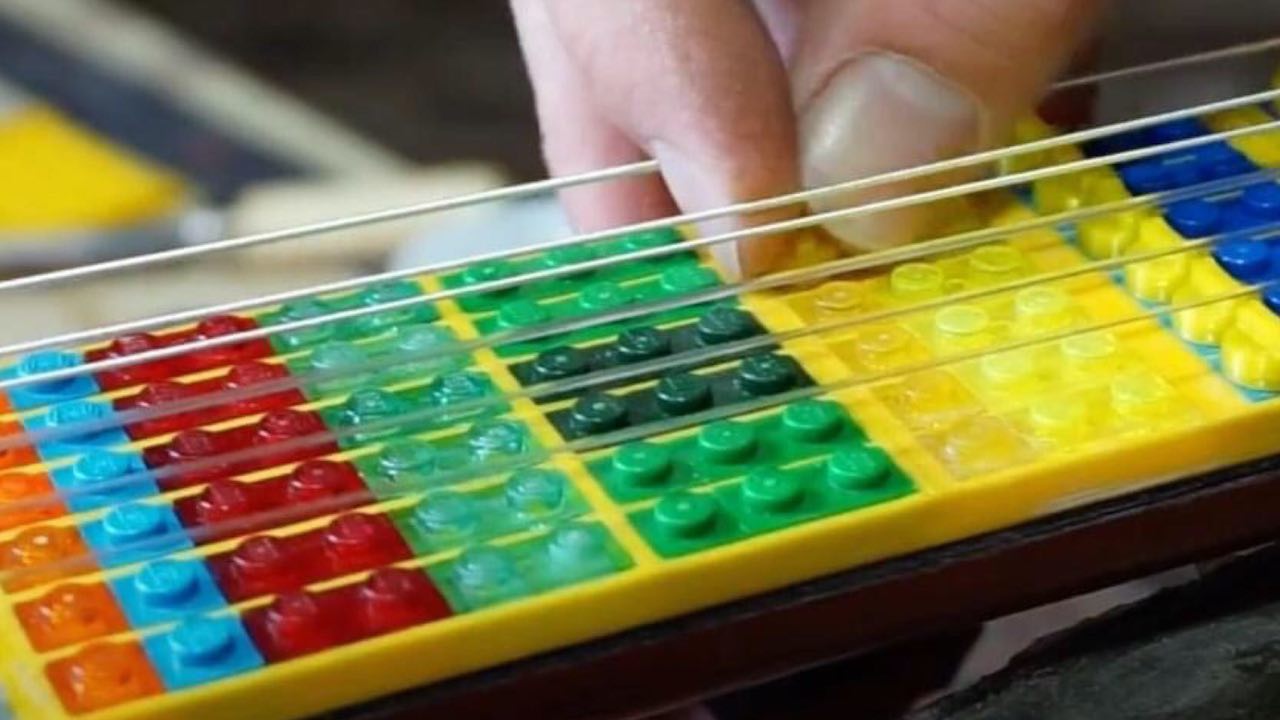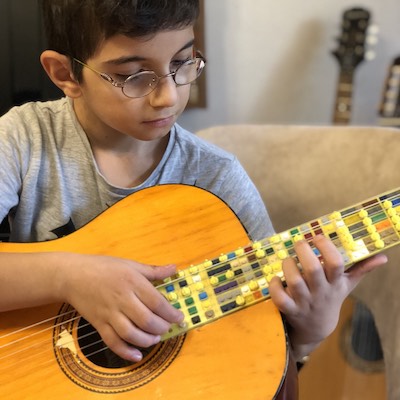Lego Microtonal Guitar
Unlike all playable Lego guitars in the world, Lego microtonal guitar is the first Lego guitar with a fretboard made out of Legos. All you need is a 3D printer and Lego pieces to have the fretboard ready to be inserted onto a standard guitar neck.
 The main design idea was built upon simplicity. It was designed like a toy which also works well on the stage. Minimalist design focused on combining microtonality with Lego's modular and easy-to-use features. It is unique because Legos never been used for this purpose before. It gives a new tool to the Lego world, such as a musical instrument or a music learning/teaching tool. Modular Lego frets let musicians easily change the microtones in seconds. Interestingly, Lego microtonal guitar attracts people from all ages.
The main design idea was built upon simplicity. It was designed like a toy which also works well on the stage. Minimalist design focused on combining microtonality with Lego's modular and easy-to-use features. It is unique because Legos never been used for this purpose before. It gives a new tool to the Lego world, such as a musical instrument or a music learning/teaching tool. Modular Lego frets let musicians easily change the microtones in seconds. Interestingly, Lego microtonal guitar attracts people from all ages.Additive manufacturing technique helped us during the design and manufacturing of the instrument. It is replicable and open to collaboration. Anyone can convert his/her guitar into Lego microtonal guitar just in a day via using developed 3d printing kit and guidelines.
Lego microtonal guitar has two unique musical features that is not possible on the standard guitars:
1) You can play tunings other than 12 tone equal temperament such as traditional music of Turkey, India, Indonesia, Japan or early music such as Renaissance and Baroque era tunings.
2) You can revolutionize the standard guitar education for kids by integrating kids favourite toy into the guitar. Without any added individual frets, the Lego guitar is fretless. The beginner student can insert the needed amount of frets for the related pieces which makes playing easier than the standard guitar. Besides, learning music theory is very effective on this guitar. By changing the fret locations, the logic of scales and chords can be learnt easily through visual memory.
Atlas Çoğulu, Tolgahan Çoğulu and Ruşen Can Acet.
: Guitarist

The first prize winner at Georgia Tech Guthman Musical Instrument Competition in 2014 and People’s Choice Award winner in 2021, Tolgahan Çoğulu, designed his "Adjustable Microtonal Guitar" in 2008. He designed the “Lego Microtonal Guitar” in 2020 with his son Atlas Çoğulu and Ruşen Can Acet. His first CD with microtonal guitar, Atlas, was published by Kalan Music in 2012. His microtonal guitar has taken him to many festivals and universities in 34 countries. Tolgahan is building a repertoire for microtonal guitar with more than 40 composers involved at this point.
In 2019, he became a Professor in Guitar at Istanbul Technical University’s Turkish Music State Conservatory, where he had founded the classical guitar department in 2010 and the world’s first microtonal guitar department in 2014. His second CD ‘Microtonal Guitar Duo’ has been published by Kalan Music in June 2015. His recording of William Allaudin Mathieu’s three-movement ‘Lattice-İşi’ in just intonation was published in the US by Cold Mountain Music in 2016.
Tolgahan completed a research project entitled ‘Historical Tunings on the Microtonal Guitar’ at the University of Bristol in 2016 for 12 months. Between 2015-2017 he collaborated with the University of Music Würzburg for the project ‘Creating and Presenting a Repertoire for the Microtonal Guitar’ supported by DAAD in which 12 composers wrote pieces for microtonal guitar and ensemble.
He has been organising the world's first “Microtonal Guitar Competition” since 2016. His book ‘Microtonal Guitar’ was published in 2018 by Mojo Roots Music, co-authored by Fernando Perez. His latest album ‘Microtonal’ was published in 2018 by Ahenk Music. Currently, he is teaching at Istanbul Technical University Turkish Music State Conservatory and Centre for Advanced Studies in Music.
In 2019, he became a Professor in Guitar at Istanbul Technical University’s Turkish Music State Conservatory, where he had founded the classical guitar department in 2010 and the world’s first microtonal guitar department in 2014. His second CD ‘Microtonal Guitar Duo’ has been published by Kalan Music in June 2015. His recording of William Allaudin Mathieu’s three-movement ‘Lattice-İşi’ in just intonation was published in the US by Cold Mountain Music in 2016.
Tolgahan completed a research project entitled ‘Historical Tunings on the Microtonal Guitar’ at the University of Bristol in 2016 for 12 months. Between 2015-2017 he collaborated with the University of Music Würzburg for the project ‘Creating and Presenting a Repertoire for the Microtonal Guitar’ supported by DAAD in which 12 composers wrote pieces for microtonal guitar and ensemble.
He has been organising the world's first “Microtonal Guitar Competition” since 2016. His book ‘Microtonal Guitar’ was published in 2018 by Mojo Roots Music, co-authored by Fernando Perez. His latest album ‘Microtonal’ was published in 2018 by Ahenk Music. Currently, he is teaching at Istanbul Technical University Turkish Music State Conservatory and Centre for Advanced Studies in Music.
Connect with Atlas Çoğulu, Tolgahan Çoğulu and Ruşen Can Acet.
How I can help you:
Ruşen Can Acet is a luthier. He has been making the instrument kemane with composite materials. He can help others about instrument making.
Ruşen Can Acet is a luthier. He has been making the instrument kemane with composite materials. He can help others about instrument making.
How you can help me:
Follow us on YouTube and Instagram.
Follow us on YouTube and Instagram.
If you like this project, please make a small donation to the artist.